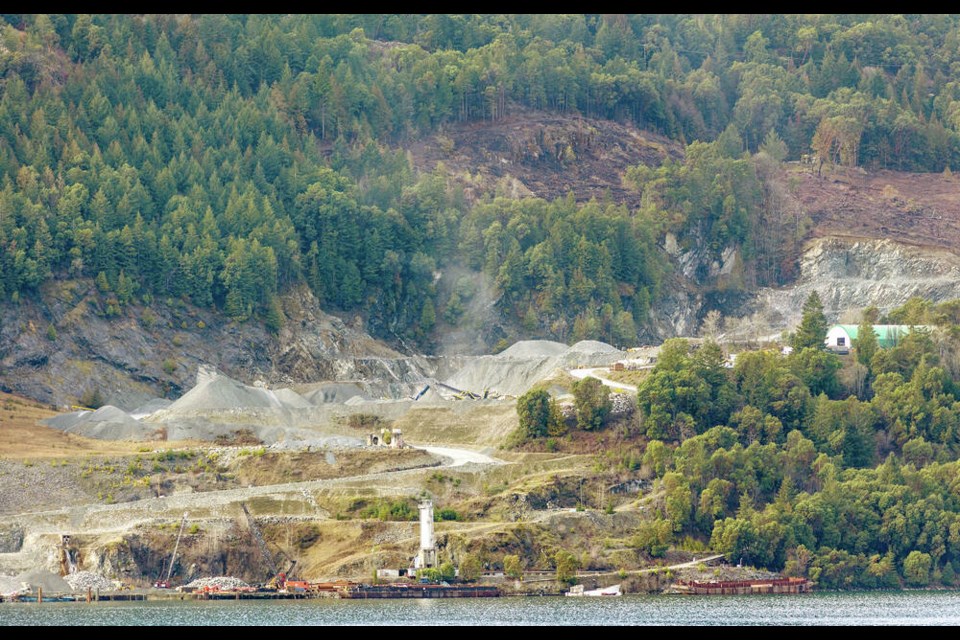Green Party MLA Adam Olsen says he has not given up hope that a plan to expand an aggregate quarry at the Bamberton site will face environmental scrutiny — despite a preliminary report recommending that an application for an environmental review be declined.
“If this is a fait accompli, then our environmental assessment system is broken and needs to be updated,” said Olsen, who represents Saanich North and the Islands.
Olsen said B.C.’s Environmental Assessment Office, which made the recommendation, might be “underestimating the passion with which the local community here disagrees with them, and they need to be very careful about that.”
Olsen said he has fielded hundreds of calls and emails from people concerned about the project on Saanich Inlet, and has encouraged them to be part of the assessment office’s consultation process. An online information session is set for 6:30 to 8 p.m. on Thursday.
“I think if [the EAO] listened to the hundreds of people that have already emailed them, and to the people that I’ve been talking to, I think a review is what this community and this neighbourhood wants.”
The draft report recommending that Environment Minister George Heyman decline to designate the Bamberton aggregate quarry expansion as a reviewable project is subject to public comment until Feb. 14.
A final report will be written after the public comment period wraps up, and will be sent to Heyman for a decision.
The Saanich Inlet Protection Society requested the review after the Malahat First Nation applied to increase the size and production of the existing quarry, extend its dock on the Saanich Inlet, and expand a soil deposit site.
The preliminary Environmental Assessment report said the dock extension and soil deposit site could not be reviewed, as they are substantially underway, and recommended against reviewing the quarry.
Society president Eric Falkenberg-Poetz said the group is deeply disappointed with the recommendations, adding the draft report “completely misrepresents” the reasons for an environmental assessment request for the foreshore lease and “ignores numerous last-minute changes made by Malahat Investment Corporation to the quarry expansion.”
Malahat Investment Corporation is operated by the Malahat First Nation, which purchased the 525-hectare Bamberton development site in July 2015.
The Green Party has criticized the legislation governing mine permits, saying the process of obtaining permits needs to be more transparent and involve the community.
The party also noted that under existing legislation, quarries being expanded by less than 50 per cent of their current size are not subject to environmental review, meaning they could keep applying for small expansions without any kind of environmental oversight.
In order to automatically force an environmental assessment, quarry-expansion plans must include both an increase of more than 50 per cent of the previously permitted size and have an annual production rate in excess of 250,000 tonnes, the province says.
The proposed quarry expansion at Bamberton would increase the disturbance area of the quarry from 39.3 ha to 45.7 ha, an expansion of 16 per cent. At the same time, the production capacity of the quarry would nearly double to 479,000 tonnes per year from 240,000.
According to the Environmental Assessment Office, the 16 per cent expansion of the disturbance area corrects the size of the expansion that was included in previous reports. At one point the office suggested expansion was less than one per cent.
Even though it is larger than first believed, the 16 per cent figure is a significant scaling back of original plans.
A letter from quarry operator Coast Mountain Resources that was included in materials submitted to the Environment Assessment Office noted an earlier application would have increased the quarry’s disturbance area by 47 per cent.
Olsen said he has been told there is little appetite to change the regulations.
“The minister might not have a desire to update this, but the public that’s engaged in this process and seeing how it’s playing out on the ground certainly disagree,” he said. “The way it’s currently set up, this project continues to grow and grow and grow with no environmental assessment. That’s absurd.”
Olsen said the fact that Malahat First Nation has decided to reduce the size of the expansion and instead dig deeper to remove more rock from the quarry further underlines problems with the system.
“It’s making a mockery of it and showing just how much of a sham it actually is,” he said. “If this project was new, it would require an environmental assessment because of the volume of aggregate that’s being taken out, so why doesn’t it require a review for an expansion?”
Olsen said he understands the project represents economic development for the Malahat First Nation, and that the site has always been an industrial zone. But he argues there are many ways to raise revenue and said residents and politicians should not be afraid to push back on projects just because they are being done by a First Nation.
“Just because First Nations are doing the activity doesn’t mean that the activities that they’re doing are an environmentally sound practice, and what’s happening over there is not environmentally sound,” said Olsen, a member of the Tsartlip First Nation.
“I’ve always been taught to leave a small footprint. I’ve always been taught to leave it better than I found it,” he added. “Just because Indigenous nations are choosing to engage this as economic development does not make it OK in a climate emergency.”
>>> To comment on this article, write a letter to the editor: [email protected]




